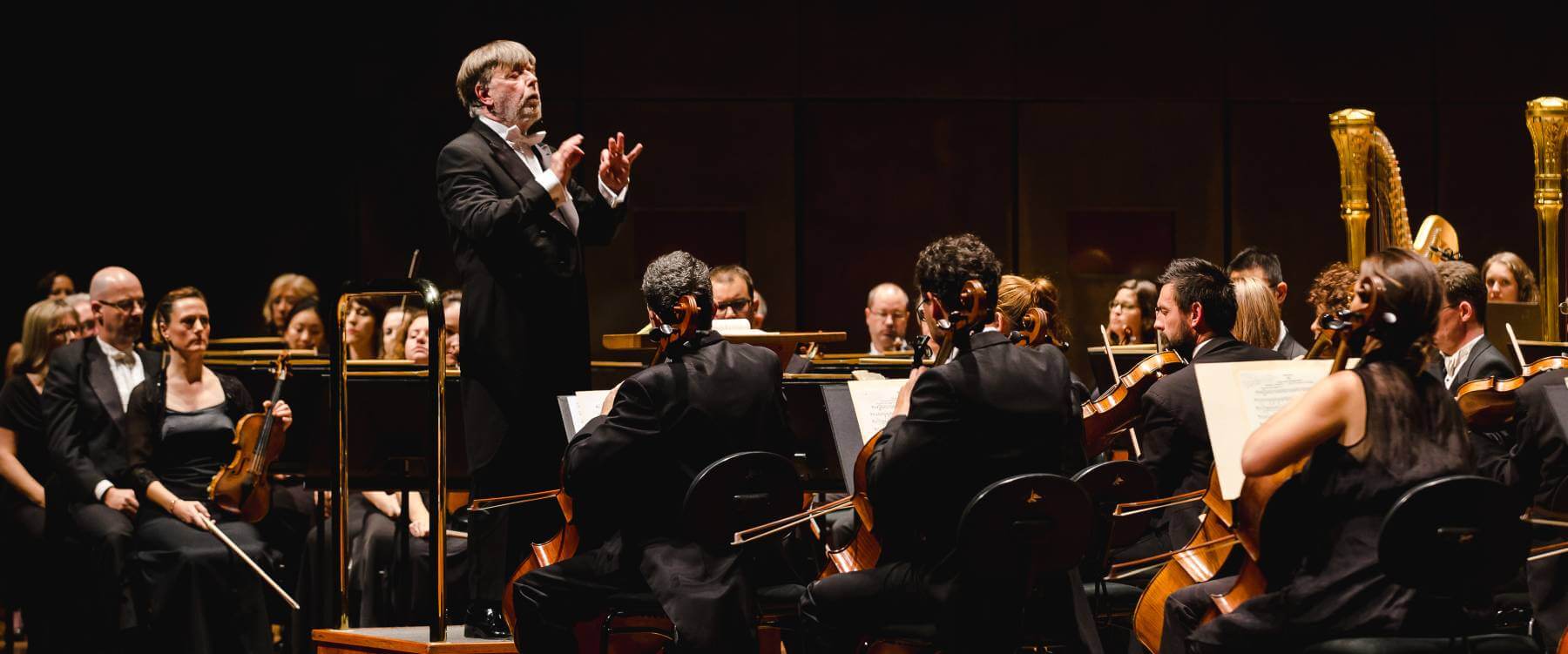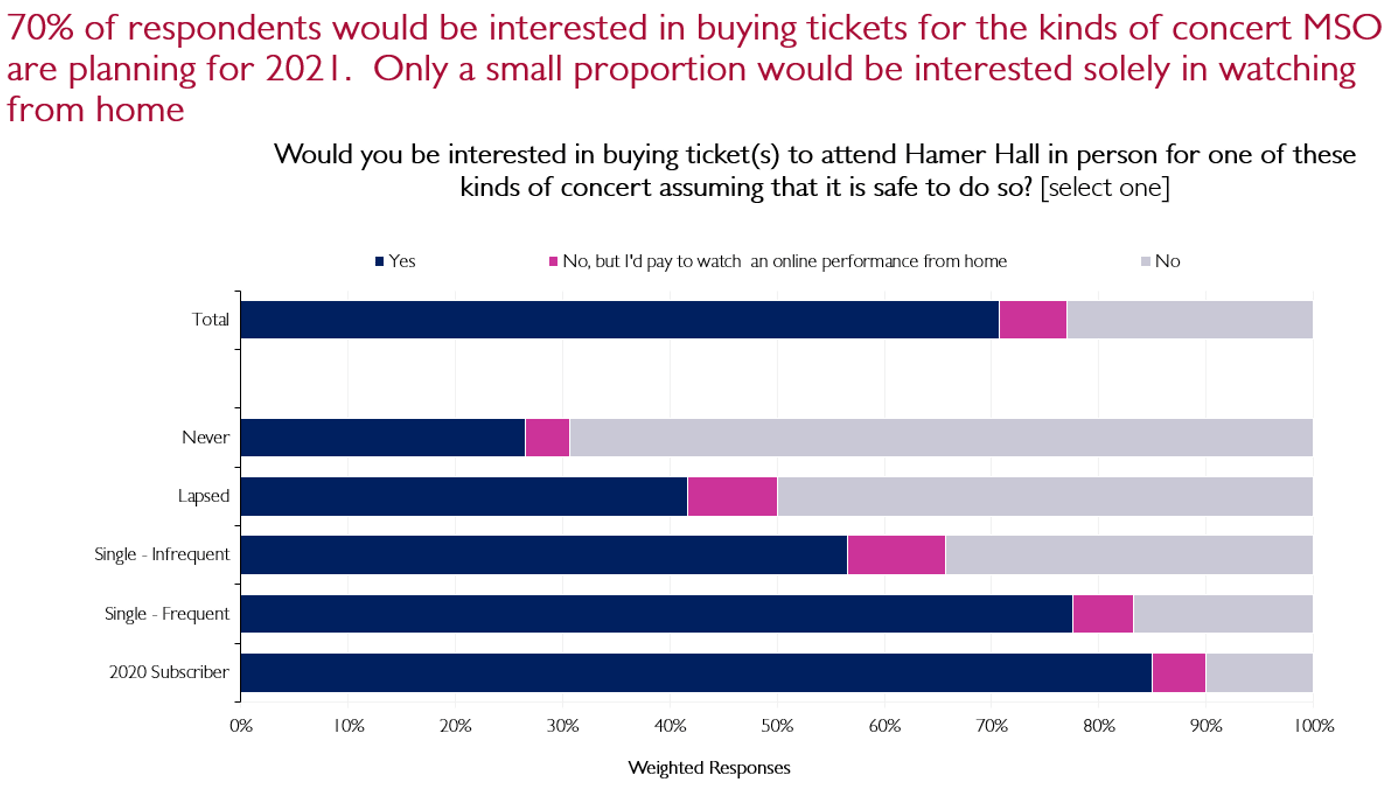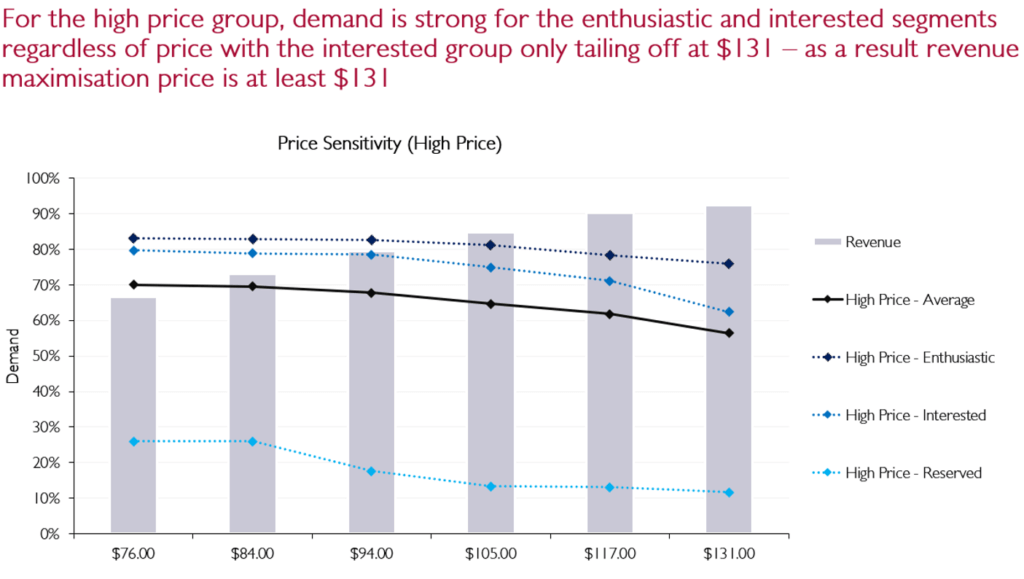Case Study | How Melbourne Symphony Orchestra Used Advanced Analysis to Plan for the 2021 Season

Jamie Alexander
Vice President, Growth and Development
For one orchestra, what began as a pricing survey for classical music concerts in 2021 also revealed wide-reaching insights into patrons’ willingness to pay for digital content, their real intentions about returning to performances in person, and their preferences around repertoire, artist, and concert times.
How do you plan for a new season in the middle of a global pandemic? What is possible given wide-ranging uncertainties? And how do you make what is possible work safely and financially?
Melbourne Symphony Orchestra (MSO), one of Australia’s leading orchestras, was not going to wait for the circumstances to change. Instead, like so many other cultural organizations, they assessed the situation, asked what is possible, and came up with a plan for a new season of concerts for 2021.
THE PROJECT
MSO commissioned JCA partner Baker Richards (BR) to run a Patron Preference Analysis to test their audience’s interest in a proposed new season format and, importantly, to find out how much they would be willing to pay for tickets to attend.
Using a specialist primary research technique known as conjoint analysis, BR worked with MSO to design a survey they sent to their patrons to find out how valuable different elements of their offer were to different audience segments. The survey guided participants through an experiment which can be used for forecasting, modeling, and segmenting patron intentions.
The central scenario revolved around presenting participants with a high-level description of how the 2021 season might work, but with several changing elements in relation to:
- Repertoire
- Soloist
- Time of concert
- Ticket price
This way, MSO could see what the impact of each individual element on demand.
Participants were offered a variety of repertoire choices. Due to expected flight restrictions, the choice of Australian and international artists was also tested.

The start time of the concert was important—MSO wanted to test the possibility of having two concerts in the same evening, allowing enough time between the end of the first concert and the start of the second to turn the venue around. Traditionally concerts had started at 7:30 p.m., but even with a reduced overall length, starting a concert at 7:30 p.m. and leaving enough time to present another, later concert would mean a very late start for the second performance.
A range of prices was tested for tickets to these concerts, ranging from $45 to $131, with customers initially split into two segments, based on self-determined price sensitivity, so that they could determine the optimum price of the lowest priced seats in the auditorium (for the price sensitive customers) as well as the highest (for the non-price sensitive customers).
In addition to testing interest in the live concerts, MSO also wanted to know what people would pay to watch the concerts online from home in addition to, or instead of, attending live concerts.
This version of the case study does not include the results of the digital pricing analysis due to commercial sensitivity. An updated version will follow once MSO have launched their digital program.
WILLINGNESS TO ATTEND
BR’s findings were encouraging. Firstly, most customers (70%) were interested in buying tickets for the proposed 2021 season, provided there were sufficient safety measures in place. A further 6% were only interested in watching online from home, and the rest were not interested at all.
Of those that were interested, the majority (80%) usually purchased mid to high-priced tickets, indicating less price sensitivity than the remaining 20%, who usually opted for the lowest priced tickets. Knowing the proportion of non-price sensitive vs price sensitive customers helped inform decisions around the optimal number of seats available at each price point across the auditorium. But what should those price points be?

THE REVENUE MAXIMIZATION PRICE
The revenue maximization price is the point at which there is sufficiently high demand that either lowering or raising price would result in a loss of revenue, either because the additional demand at lower prices is not enough to counteract the loss in revenue from a lower price, or demand drops off too much as prices rise.
The patron preference analysis revealed that, for the non-price sensitive segment, demand remained strong all the way up to $131—the maximum price we tested—so much so that as a result, the revenue maximization price was at least $131. The relatively small drop in demand from $76—the lowest price we tested for this segment—to $131 suggested that it could possibly be pushed further. Given prices for full-length MSO concerts in the past had a top price of $155, it was reassuring to know that customers still perceived a lot of value in a shorter-length concert.

For the price sensitive segment, the prices tested ranged from $44 to $75. Demand dropped off at two key thresholds: $50 and $75, but was sufficiently strong at $67 to result in the maximum amount of income. $67 is higher than MSO’s previous low price, but given the limited capacity from a socially distanced auditorium, increasing the bottom price to $67 will help to sustainably maximize income.
Many organizations have felt under pressure to lower prices across the board—so we compared the impact on income from reducing the top price from $131 to $94, and the bottom price from $67 to $44. This would produce a 30% drop in income and generate only an additional 2% in demand. If price is not the obstacle holding some patrons back from buying tickets, discounting is not the answer!
REPERTOIRE, PERFORMER, AND START TIME PREFERENCE
Price doesn’t operate in isolation and demand is also driven by the other elements of the offer, which in this case relates to repertoire, soloist, and concert start time. The importance of each of these elements (along with price) varies by customer. Understanding this variation means you can pinpoint the most valuable elements of your offer, in line with what your customers are looking for, ensuring you’re able to balance value sought with price offered.
Repertoire
In terms of repertoire, the analysis demonstrated that “Classics” were twice as popular as either “19th Century Favorites” or “20th Century Marvels”. This suggests that a balanced season should be made up of repertoire that is 50% “Classics”; 25% “19th Century Favorites” and 25% “20th Century Marvels”, to ensure an even spread of demand across all concerts.
Performer
The most popular choice for soloist were those drawn from MSO’s own players, rather than other Australian-based artists or non-classical icons. This is good news for MSO as it gives them the confidence to promote their own talented musicians.
Start Time Preference
The preferred time of concerts was 7:30 p.m. by a clear margin, compared to the next most attractive time slot of 6 p.m. Nearly everyone was averse to a concert starting at 9 p.m. But having a concert start at 7:30 p.m. didn’t leave time afterwards for an additional concert in the same evening.
So, what would be the impact on demand if rather than a single 7:30 p.m. concert, MSO were to present a 6 p.m. concert and an 8:30 p.m. concert on the same night? Assuming both were priced identically, presenting two concerts resulted in only a small increase in demand. However, where the costs of presenting an additional concert on the same night were marginal, and assuming that demand for any one concert would outstrip the restricted supply, then doubling capacity increases volume and helps audiences to feel safer, spreading demand across two concerts and maximizing revenue.
IN CONCLUSION
Having come up with a proposal for 2021 and undertaken the appropriate research to test elements of the plan, the MSO now understands patron preferences and has identified the key price points. They are now equipped with the relevant evidence to make informed decisions about their next season.
MSO have the confidence to set price points in line with their customers’ willingness to pay at both the top end ($131) and low end ($67). And what’s more, by overlaying each customer’s willingness to pay against their preferred section of Hamer Hall, MSO are also able to determine what proportion of each section should be higher and lower priced.
They know what a balanced season would look like in terms of repertoire, that customers are more attracted by the prospect of seeing MSO soloists, and that there is potential to offer two concerts in the same evening at 6 p.m. and 8:30 p.m. (provided the turnaround logistics work).
MSO undertook Patron Preference Analysis, for real-world concerts and digital streams.
Melbourne Symphony Orchestra is one of the many clients that are launching dynamic new seasons in the face of COVID-19. We’re happy to share our clients’ journeys, and provide advice for your 2020-21 and 2021-22 seasons. Contact us directly or learn more about our consulting offerings for COVID Recovery.

